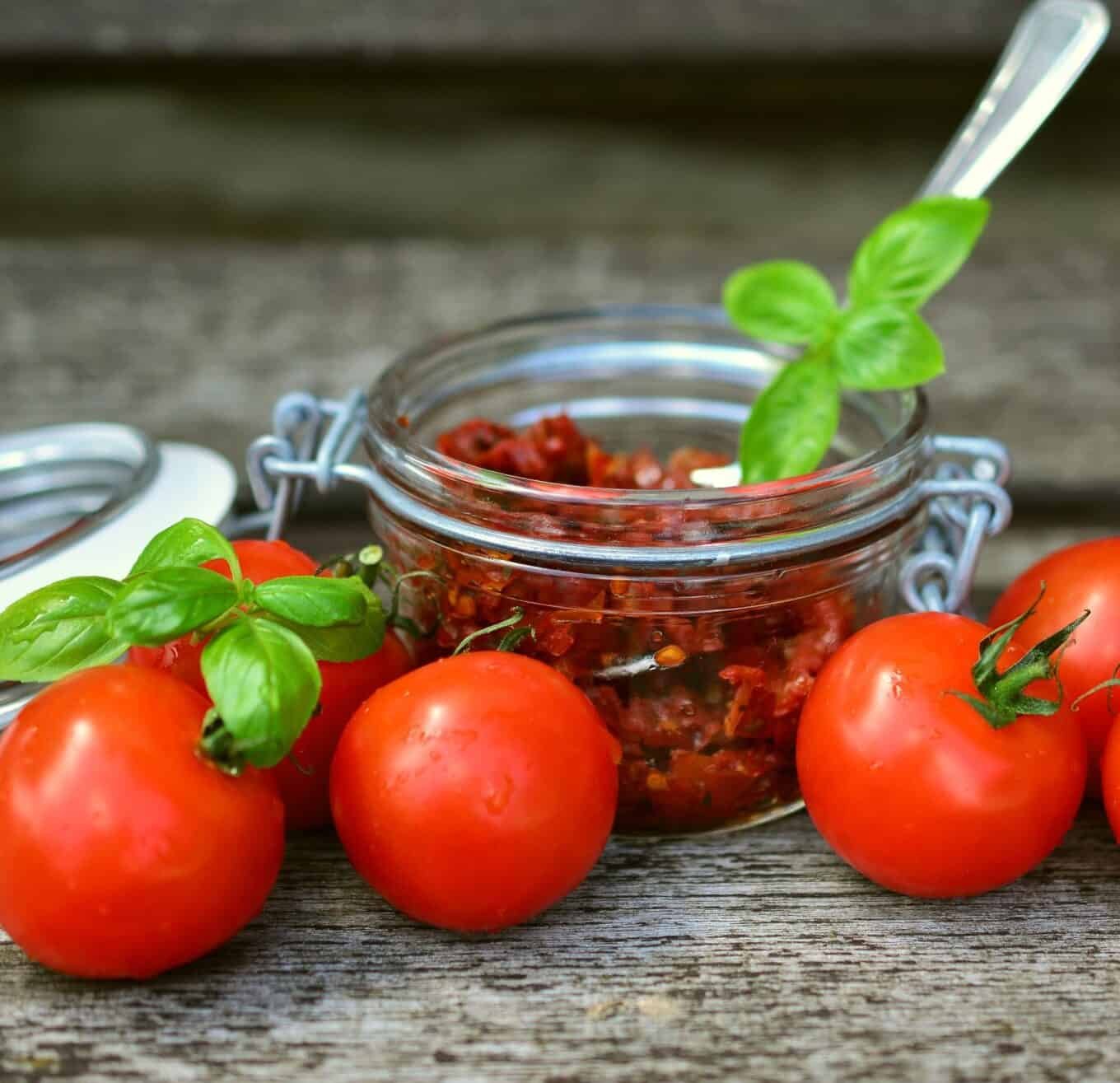Unlock the full potential of your dehydrator with The Ultimate Guide to Dehydrator Recipes! This comprehensive ebook is your go-to resource for crafting delicious, healthy, and long-lasting snacks and meals. Perfect for beginners and experienced dehydrating enthusiasts alike, this guide provides everything you need to know to boost your kitchen game.

How to Make Sun Dried Tomatoes in a Food Dehydrator
If you don’t live under a rock, then you’ve had tomatoes at least once before, and you might be wondering how to make sun dried tomatoes in a food dehydrator.
These plump and juicy fruits (yes, they’re technically both vegetables and fruits!) are great in many recipes. But their high moisture content is their downfall; you must use them quickly or risk them rotting.
A good solution is to dehydrate tomatoes. They won’t taste exactly the same as before, but you’ll get to enjoy them for just a bit longer.
In this article, I’ll tell you about the history of sun-dried tomatoes, why they’re good for you, how to make easy sun dried tomatoes in a dehydrator, and more.
The History of Sun-Dried Tomatoes
It’s not 100% clear where sun-dried tomatoes originated from. But it’s heavily suspected the Aztecs were the first to create them. This may come as a surprise, as you probably associate sun-dried tomatoes with Italian cuisine, and not Latin American food as much.
Back in 700 AD, Aztecs cultivated and sun-dried their tomatoes so they wouldn’t have to deal with quick-rotting veggies. They did so in a very primitive manner; they just salted the tomatoes and left them in the sun to dehydrate.
Later on, Italians got their hands on tomatoes and put their own spin on sun-drying them. During hot summers, they’d set their tomatoes out on their ceramic rooftops to dehydrate them in a similar fashion.
Today, tomatoes are treated with sulfur dioxide or salt before they’re dehydrated; this improves the quality of the final product. Quite surprisingly, modern suppliers of sun-dried tomatoes still leave them out in the sun for 4 to 10 days.
What are Sun Dried Tomatoes?
Sun dried tomatoes are a type of preserved tomato that has been dried to remove excess moisture, resulting in a chewy and flavorful ingredient. They are made by drying fresh tomatoes, either using the sun, a dehydrator, or an oven, to concentrate their natural flavors and textures. Sun dried tomatoes are a popular ingredient in many cuisines, particularly in Mediterranean and Italian cooking, and are often used to add flavor and texture to dishes such as pasta sauces, salads, and sandwiches.

Why Sun-Dried Tomatoes Are Good for You
As you can guess, you’ll reap many of the same benefits you’d get from eating fresh tomatoes. But what exactly are they?
For one, dehydrated tomatoes have plenty of antioxidants. To understand how these are beneficial, you have to first understand what free radicals are.
Free radicals are byproducts that come from chemical reactions in your body. If they’re not eliminated, they can cause damage and bring on diseases and cancer.
Antioxidants are great because they get rid of free radicals in your body by neutralizing them. Sun-dried tomatoes, in particular, have vitamin A, lycopene, lutein, and zeaxanthin, which are all antioxidants.
Getting plenty of antioxidants will not only lower your chances of getting certain diseases and cancers, but they can also help your heart health and fight signs of aging.
One of the above antioxidants, lycopene, is a carotenoid pigment. This is what gives tomatoes their bright red color. In addition to helping heart health and rejuvenation, lycopene can also reduce cholesterol and lower the risk of osteoporosis in women who are post-menopausal.
Surprisingly, sun-dried tomatoes have plenty of calcium in them too, as well as magnesium and phosphorus. All 3 combined help keep your bones nice and strong.
Choosing the Right Tomatoes
When it comes to making sun dried tomatoes, the type of tomato used is crucial. The best tomatoes for sun drying are those that are meaty and have a low water content, such as Roma, Plum, and Cherry tomatoes. These varieties have a higher solid content than other tomatoes, which makes them ideal for drying. Other varieties, such as Beef Steak and Rutgers, can also be used, but they may require slicing thinner and removing the core to ensure even drying.
Preparing Tomatoes for Dehydrating
Before dehydrating tomatoes, it’s essential to prepare them properly. Start by washing the tomatoes under cold water, then slice them into thin pieces, depending on the desired thickness. Remove any stems or leaves, and place the tomato slices on a paper towel-lined plate to remove excess moisture. This step is crucial to ensure that the tomatoes dry evenly and prevent them from becoming too sticky or developing off-flavors.
How to Make Sun-Dried Tomatoes in a Dehydrator
So you’re convinced about the health benefits of sun-dried tomatoes, plus you love the taste of them. So how do you go about making them?
First, get some fresh tomatoes, wash them, and remove the stems. Then, slice tomatoes into thin pieces; the thinner you cut them, the less time they’ll need in the dehydrator. For this reason, I recommend you cut them into 1/4th-inch slices.
Get the dehydrator trays and place the tomato slices across them. If you’d like some flavor in your sun-dried tomatoes, here’s where you can get creative. At this step, you can sprinkle some herbs over the slices, such as basil, oregano, or thyme.
To dehydrate your tomato slices, you’ll want to follow this general rule of thumb: put your dehydrator on 150 degrees Fahrenheit for a maximum of 10 hours. The exact time to completely dry tomatoes will depend on how much moisture was originally in your tomato slices, so make sure you check every hour after the first 4 hours.
When the slices become leathery in texture, that’s when you’ll know they’re done. You can then store them in an air-tight container in either your fridge or freezer. The shelf life should be anywhere from 6 months to a year.
Setting Up the Dehydrator
To dehydrate tomatoes using a dehydrator, start by setting the temperature to 135°F – 155°F (57°C – 68°C). Place the tomato slices in a single layer on the dehydrator trays, making sure not to overlap them. You can also sprinkle the tomatoes with salt, dried herbs, or other seasonings to enhance their flavor. Close the dehydrator lid and set the timer according to the manufacturer’s instructions, usually between 6-12 hours.
Monitoring the Dehydration Process
It’s essential to monitor the dehydration process to ensure that the tomatoes dry evenly and don’t become too dry or brittle. Check on the tomatoes every few hours to rotate the trays and ensure that they are drying consistently. If using a dehydrator, you can also check the temperature and humidity levels to ensure that they are within the optimal range. Once the tomatoes are dry and chewy, remove them from the dehydrator and store them in an airtight container to preserve their flavor and texture.
How to Make Sun-Dried Tomatoes in an Oven
If your dehydrator’s broken or you haven’t gotten one yet, not to worry! You can still make these delicious morsels.
All you have to do is follow all the same steps above, but set your oven at 150 degrees Fahrenheit instead. Also, instead of 10 hours, you’ll most likely need only a few hours.
What to Put Sun-Dried Tomatoes In
You might be most familiar with sun-dried tomatoes in pasta. But there are many more possibilities for these tasty things! Fresh herbs can also be used to enhance the flavor of these dishes. Here are some suggestions:
For some of these recipes, you’ll have to reconstitute your sun-dried tomatoes, especially if you choose not to store them in olive oil. Simply soak them in warm water 30 minutes prior to using them. If you don’t use all of them, then store the sun-dried tomatoes in olive oil in the fridge.
If you’re looking for other recipes to make full use of your dehydrator and to make fuller meals, then take a look at my other dehydrator recipes. You might also enjoy trying a sun dried tomatoes recipe that includes detailed instructions and tips on storage duration.
Create Delicious Dishes With Homemade Sun-Dried Tomatoes
After reading this article, now you know how to make sun-dried tomatoes in a dehydrator. Not only that, but you’ve also learned about the history of sun-dried tomatoes, why they’re good for you, and what to put them in.
With your newfound knowledge, there’s hardly an excuse for not making homemade sun-dried tomatoes. So get to dehydrating and supplying yourself with some great additions to your meals!
If you don’t have a dehydrator yet, or you’re considering replacing your old one, then check out my blog posts about the best dehydrators on the market.
FAQ
Can I make sun-dried tomatoes in a dehydrator?
Yes, you can easily make sun-dried tomatoes in a dehydrator. Simply slice tomatoes, place them on dehydrator trays, and set the temperature to 135°F – 155°F. Check periodically until they reach a chewy texture.


